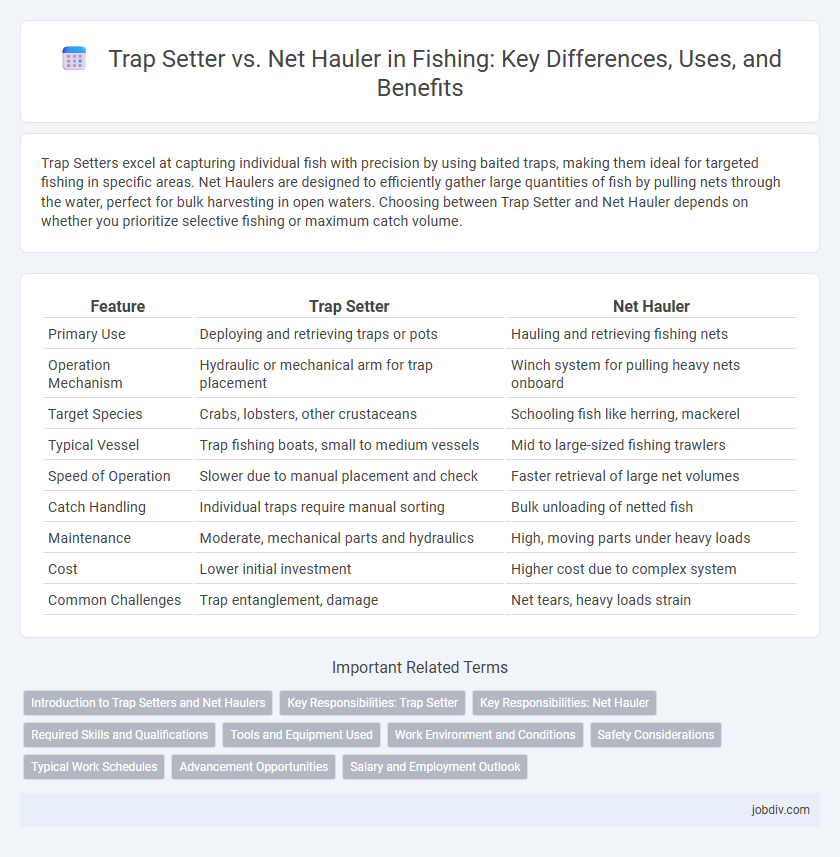Trap Setters excel at capturing individual fish with precision by using baited traps, making them ideal for targeted fishing in specific areas. Net Haulers are designed to efficiently gather large quantities of fish by pulling nets through the water, perfect for bulk harvesting in open waters. Choosing between Trap Setter and Net Hauler depends on whether you prioritize selective fishing or maximum catch volume.
Table of Comparison
| Feature | Trap Setter | Net Hauler |
|---|---|---|
| Primary Use | Deploying and retrieving traps or pots | Hauling and retrieving fishing nets |
| Operation Mechanism | Hydraulic or mechanical arm for trap placement | Winch system for pulling heavy nets onboard |
| Target Species | Crabs, lobsters, other crustaceans | Schooling fish like herring, mackerel |
| Typical Vessel | Trap fishing boats, small to medium vessels | Mid to large-sized fishing trawlers |
| Speed of Operation | Slower due to manual placement and check | Faster retrieval of large net volumes |
| Catch Handling | Individual traps require manual sorting | Bulk unloading of netted fish |
| Maintenance | Moderate, mechanical parts and hydraulics | High, moving parts under heavy loads |
| Cost | Lower initial investment | Higher cost due to complex system |
| Common Challenges | Trap entanglement, damage | Net tears, heavy loads strain |
Introduction to Trap Setters and Net Haulers
Trap setters employ strategically placed traps to capture fish and crustaceans, optimizing their catch in specific habitats like rocky seabeds or coral reefs. Net haulers use large nets pulled through the water or along the sea floor to efficiently gather schooling fish or bottom dwellers, enhancing volume over selectivity. Both techniques offer distinct advantages depending on target species and environmental conditions.
Key Responsibilities: Trap Setter
Trap setters specialize in deploying and retrieving various types of traps, such as crab pots or lobster cages, ensuring optimal placement in designated fishing zones to maximize catch efficiency. They regularly inspect traps for damage, maintain bait freshness, and accurately record catch data to comply with fishing regulations. Expertise in navigating waters and understanding species behavior is essential for successful trap setting operations.
Key Responsibilities: Net Hauler
Net haulers are responsible for deploying, managing, and retrieving fishing nets to maximize catch efficiency while minimizing environmental impact. They monitor net tension and positioning to prevent damage and ensure optimal fish capture, often operating specialized winches and cranes. Accurate navigation and coordination with the boat crew are essential for timely net handling and safety compliance in diverse marine conditions.
Required Skills and Qualifications
Trap setters require expertise in identifying suitable locations, setting traps securely, and handling catch without damage, demanding strong knowledge of aquatic habitats and fish behavior. Net haulers must possess physical strength, coordination, and proficiency in operating mechanical hauling equipment, along with skills in sorting and preserving fish efficiently. Both roles emphasize safety awareness, adherence to fishing regulations, and experience with maritime navigation and weather conditions.
Tools and Equipment Used
Trap setters rely primarily on traps made of wood, metal, or synthetic materials designed to capture fish or crustaceans by luring them inside. Net haulers use various types of nets such as seine nets, gillnets, or trawl nets, along with mechanized hauling devices like winches or net drums for efficient retrieval. Specialized gear including waterproof gloves, boats equipped with hydraulic systems, and storage containers are essential for both methods to ensure durability and catch preservation.
Work Environment and Conditions
Trap setter fishermen often work in calm, shallow waters, managing individual traps that require precise placement and regular retrieval, facing challenges like navigating rocky seabeds and adapting to tidal movements. Net haulers operate in more dynamic marine environments, deploying large nets from boats in open waters, contending with heavier physical demands, variable weather conditions, and the risk of entanglement or equipment failure. Both roles demand endurance and skill, but trap setters experience more localized, repetitive tasks while net haulers face broader spatial challenges and heavier manual labor.
Safety Considerations
Trap setters face risks such as entanglement with ropes and heavy gear, requiring constant vigilance and use of protective gloves and life vests. Net haulers encounter hazards including slipping on wet decks and strain from hauling heavy nets, making non-slip footwear and ergonomic equipment crucial. Both roles benefit from thorough safety training and adherence to maritime regulations to minimize accidents and injuries.
Typical Work Schedules
Trap setters typically work long hours offshore, often starting before dawn and continuing until all traps are checked and reset, which can last from 10 to 14 hours daily. Net haulers usually operate on shorter, more intense shifts, often timed around fish schooling patterns, with workdays fluctuating between early mornings and late nights depending on catch conditions. Both roles require flexible schedules adapted to seasonal fish migrations and weather conditions to maximize catch efficiency.
Advancement Opportunities
Trap setters typically have limited advancement opportunities, often progressing to lead trap setting teams or supervisory roles in small-scale fisheries. Net haulers benefit from more dynamic career paths, including positions in vessel operations management, fishing fleet coordination, or roles involving advanced net technology and maintenance. The complexity and mechanization associated with net hauling provide broader scope for skill development and upward mobility within commercial fishing industries.
Salary and Employment Outlook
The average salary for trap setters ranges from $25,000 to $35,000 annually, reflecting entry-level skills and seasonal employment in coastal regions. Net haulers typically earn higher wages, averaging between $30,000 and $45,000 per year, due to the physically demanding nature and technical skills required. Employment outlook for both positions depends largely on fishing industry regulations, with net haulers experiencing steadier demand in commercial fisheries compared to trap setters.
Trap Setter vs Net Hauler Infographic

 jobdiv.com
jobdiv.com